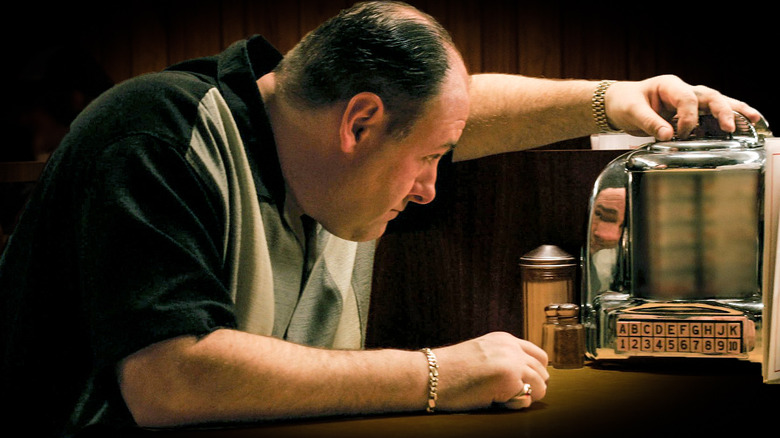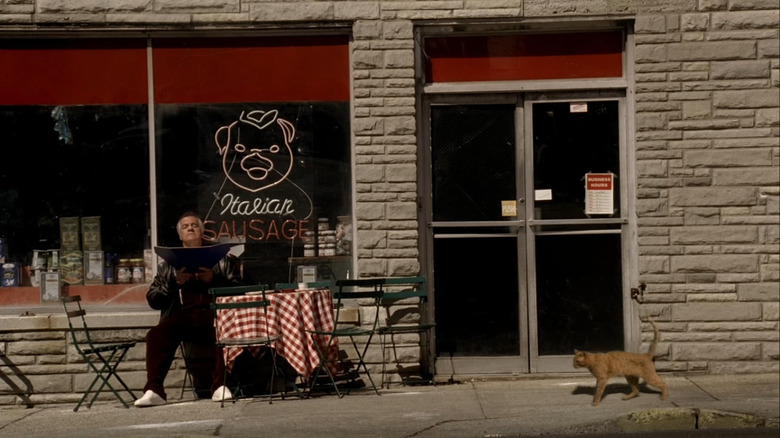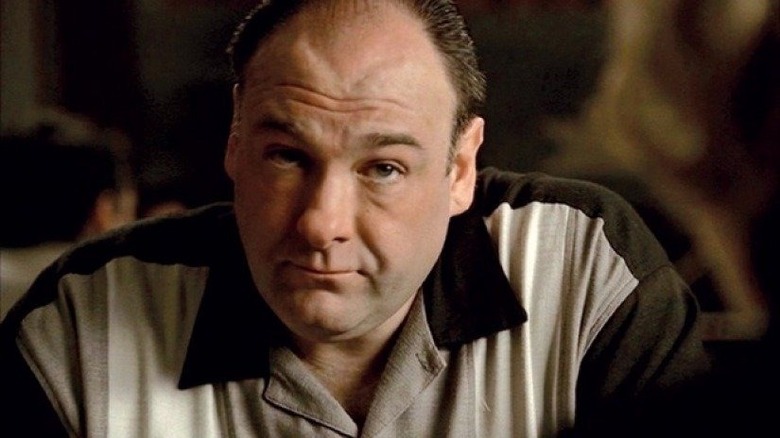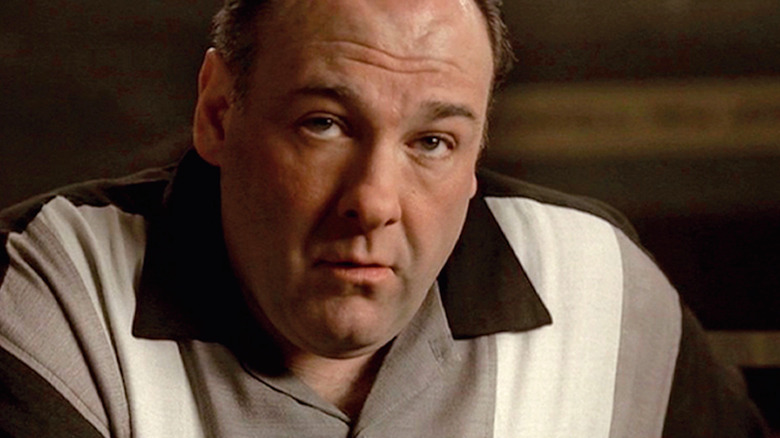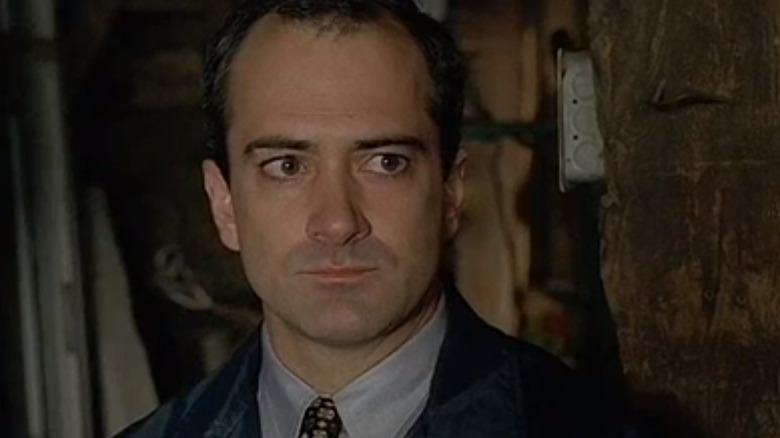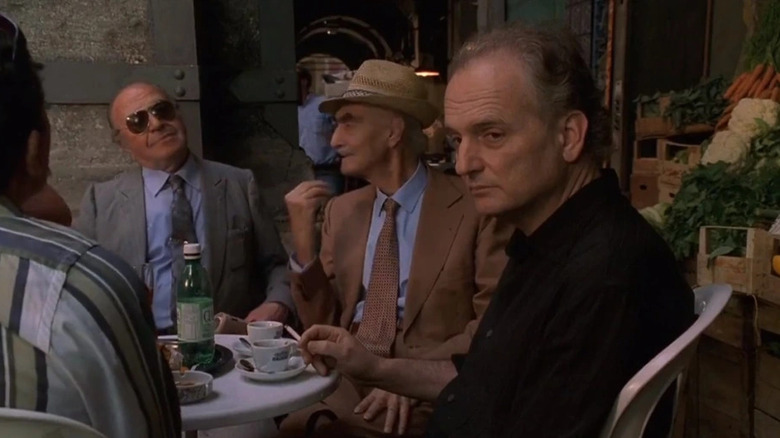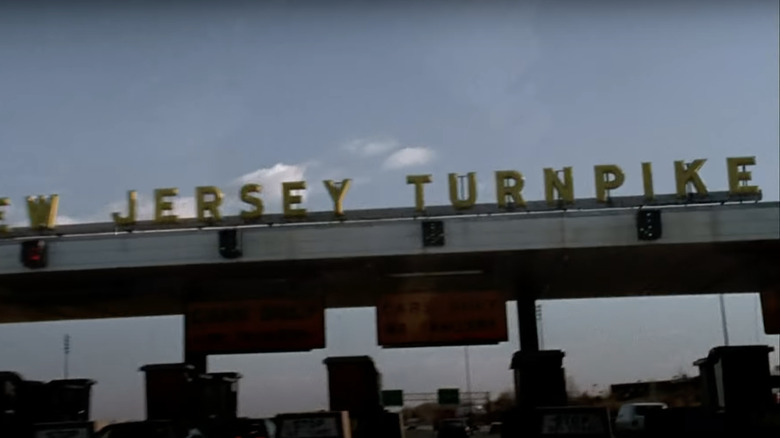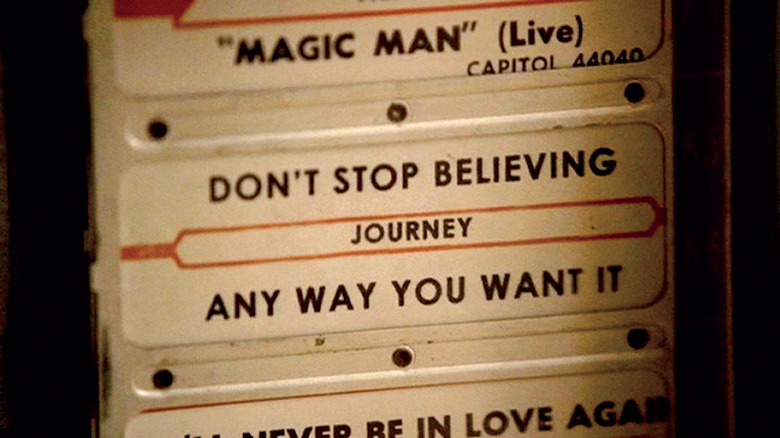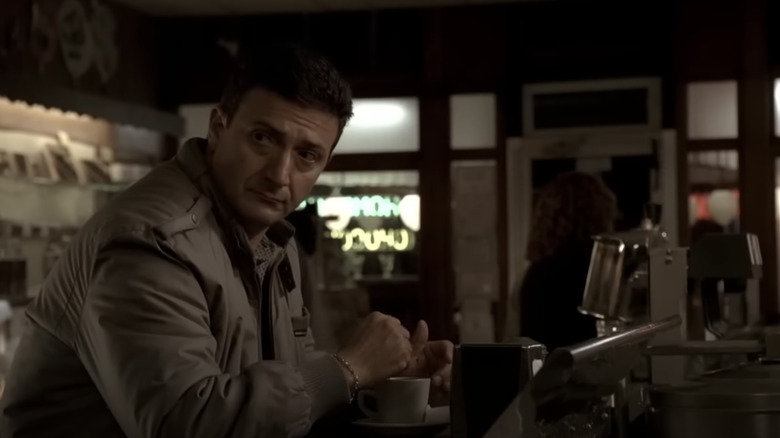The Sopranos Ending Explained: A Diner, Death, And Don't Stop Believin'
It's been 14 years since HBO's hit series "The Sopranos" ended, and people are still arguing about the last moments of the series finale. Danger surrounds antihero Tony Soprano on all sides; he's a wanted man by both the FBI and the family and crew of his recently departed nemesis, Phil Leotardo. One by one his family members join him for dinner at a local diner, but before daughter Meadow can walk in, the scene cuts dramatically to black.
People have argued for years over whether or not that meant Tony died, and just recently The Hollywood Reporter declared they finally had the answer. (Spoiler: They didn't, it's the same kind of non-answer showrunner David Chase has been giving for over a decade.)
While the prequel film "The Many Saints of Newark" gave us more insight into the history of the crime family, it didn't give us any answers on what happens down the line. Let's dig into the final episode of "The Sopranos" to dissect one of television's most powerful and divisive endings.
What's with Paulie and the cat?
Animals are hugely symbolic in "The Sopranos." Tony's ducks represent his loving side, while the bear that stalks outside their home represents the ever-present dangers that surround the family because of their unique lifestyle. The orange cat, however, is of special significance, because high-ranking mob family member Paulie (Tony Sirico) believes the cat is a jinx. The cat sits and stares at a photo of Christopher (Michael Imperioli) after his death, and even after Paulie moves the photo, the cat continues to stare at it.
Paulie explains his fears to Tony and the other wise guys: "These are snakes with fur. The old Italians'll tell ya, you can't even put 'em around a baby. They suck the breath right out."
Both Paulie and Tony view the cat as a connection to Christopher, and they both have guilt over how their treatment of him led to his downward spiral and eventual demise. (Tony feels more guilt, obviously, as the one who actually snuffed him out.) While Tony views the cat as a way to show kindness in spite of it all, Paulie sees the feline as a symbol of death. When he sees the cat, he thinks of all of his many sins, and knows the time is coming when he'll have to pay the piper.
Did Tony die?
This is the big question, isn't it? While Chase said in that THR interview that he imagined Tony dying when he first came up with the scene, he left it open-ended for a reason. Whether or not Tony kicks the bucket in the diner isn't really the important thing to focus on, because the ambiguity is what's terrifying. That ambiguity is what made fans across the country furious when the finale first debuted, and it's why people are still talking about the finale today.
Tony's death is kind of a Schrödinger's cat situation. It doesn't matter whether he's dead or alive at the end of it, because the pondering is the important part. Like Paulie's many superstitions, the specter of death will always be looming over Tony. People in his line of work don't get to retire and die of old age, they tend to get a bullet in the back or wear a pair of cement shoes and go swimming. Even if he walked out of the diner that night, he would always be looking over his shoulder. Death will always be watching, waiting, and none of Tony's feeble attempts to better himself will prevent that outcome. At some point, Tony has to die, and the diner scene establishes that it could be at almost any time. After all, not seeing your death coming and getting blindsided is a repeat theme in both "The Sopranos" and "The Many Saints of Newark." Tony's chances of death might be higher now that he's basically started a war with another crime family by killing Leotardo, but the chance was always there.
There are a handful of wilder theories out there that claim Tony actually died at other points in the series and the events thereafter are his way of processing his death, but that starts to get a little too "whole universe in a snowglobe" for me.
Why the cut to black?
"Made in America" hammers in the ambiguity with its infamous cut to black; the screen lingers on a silent void for about 10 seconds before the credits roll. A lot of contemporary viewers were baffled, believing their cable had cut out just before the final shot. It's tempting to think the harsh smash cut to nothingness is a visual metaphor for Tony being suddenly clipped. But again, the whole point of the ending is to make you think about what you just watched, so maintaining ambiguity is key.
No interpretation is truly wrong because the series refuses to state its answer. Tony will die, and it might have been in that diner, but it's just as valid to say it happened later. Critic Matt Zoller Seitz suggested:
"It could be, as I wrote in my original recap hours after the finale aired, that the character who died there was us, the spectator. We don't get to watch the show anymore. He whacked the viewer."
The cherry on top? Seitz gave this comment in a debate about the cut to black's meaning. It's telling that we, as humans, grasp for conclusions even when denied. After all, the point of the original Schrödinger's cat thought experiment is that its existence is something we simply can't know for sure.
Life rarely gives us the catharsis of a narrative or a tidy ending. Even if we're not in the same line of work as Tony, we never know when we'll die; one wrong step on a random day and that could be lights out. The cut to black and the ambiguity surrounding it captures the fundamental anxiety of being alive.
The lingering threat of the law
Tony doesn't only have to worry about the other mob families coming for him, because the Feds are on his tail, too. After giving up some basic information on a couple of Muslim locals in exchange for the whereabouts of Leotardo, Tony knows there's a good chance there's an indictment coming his way. He's only barely played ball with the FBI, giving them tiny tidbits of information without playing his hand or snitching on any of his own guys.
Tony's family hated living on the lam while they were hiding from Leotardo's crew, so how are they going to feel if Tony goes to prison? Or worse, if they have to go into witness protection? Could you see Carmela (Edie Falco) living in suburban Ohio with a minivan and a mousy brown bob haircut? No, me either. The Soprano family has gotten used to a life of luxury, and Tony knows that he could lose that at any minute the same way he could lose his life. No amount of therapy could ever help Tony deal with the anxiety of knowing he's pretty doomed, one way or the other.
What David Chase says
"The Sopranos" creator David Chase loves an anti-climax and the ending feels like another example of that. Instead of Tony dying outright, we only get to partake in paranoia about when he might die.
Chase has been asked ad nauseam about the ending, again showing people won't accept the lack of an answer. One of his earliest responses was published by the local New Jersey newspaper, the Star-Ledger, the day after the finale aired. Chase explained:
"I have no interest in explaining, defending, reinterpreting, or adding to what is there. No one was trying to be audacious, honest to God. We did what we thought we had to do. No one was trying to blow people's minds, or thinking, 'Wow, this'll (tick) them off.' People get the impression that you're trying to [mess] with them and it's not true. You're trying to entertain them."
Interviewed for "The Sopranos: The Complete Book," Chase added it was "pathetic" that people wanted Tony to die after rooting for him for so long. He also noted:
"I must say that even people who liked it misinterpreted it, to a certain extent. This wasn't really about 'leaving the door open.' There was nothing definite about what happened, but there was a clean trend on view — a definite sense of what Tony and Carmela's future looks like. Whether it happened that night or some other night doesn't really matter."
Chase's refusal to divulge anything slowly cracked. In 2008, speaking to Entertainment Weekly, he admitted (after a long pause): "There's more than one way of looking at the ending. That's all I'll say."
In 2019, while speaking to Seitz and Alan Sepinwall for their book "The Sopranos Sessions," Chase referred to an abandoned ending idea as a "death scene" for Tony. The authors clarified in a Reddit AMA that Chase wasn't referring to the final ending with this description.
Were there any alternate endings?
What was the abandoned ending that Chase described in "The Sopranos Sessions"? Tony driving through the Lincoln Tunnel to a meeting with New York mob boss Johnny Sack (Vincent Curatola), with the screen fading to white or black before he arrived. The audience still wouldn't see Tony's brains getting blown out, but the implication would be heavier. After all, in this take, Tony would be going to a meeting with a rival, not having dinner with his family.
That brings us back to that Hollywood Reporter interview, where Chase said this ending would be a reflection of the show's opening credits (Tony driving home to New Jersey from New York):
"At the beginning of every show, he came from New York into New Jersey, and the last scene could be him coming from New Jersey back into New York for a meeting at which he was going to be killed."
This time, he revealed that the final ending came to him by chance:
"I was driving on Ocean Park Boulevard near the airport and I saw a little restaurant. It was kind of like a shack that served breakfast. And for some reason I thought, "Tony should get it in a place like that." Why? I don't know. That was, like, two years before."
Chase still refuses to say one way or another what happened to Tony but he has become less guarded over the years. It seems he's accepted that fans will read too much into anything he says, even if he'd much prefer we take the ending on its own terms.
Don't Stop Believin'?
The ambiguity around whether or not Tony dies in the diner may never be solved (and it honestly probably shouldn't.) There is one burning question left about the "Sopranos" finale, however: why "Don't Stop Believin'"? Clearly Tony wasn't going to get things "Any Way You Want It," but does the Journey song have a hidden meaning for the series?
As it turns out, the "Sopranos" crew just really hated the song, and Chase thought it would be funny to use it. He had a couple of different songs in mind for the final scene, but whenever he told crew members about his Journey pick, their annoyed reactions amused him. Beyond that, it's an ironic song choice given Tony's position; the song is about surviving against the odds, and the odds are not in Tony's favor. When the scene cuts to black and ends immediately after the word "stop," it's a harsh goodbye. After all, in the world of "The Sopranos," you rarely see the end coming.
Who is 'Members Only' (and did he kill Tony)?
The camera doesn't focus on only the Soprano family during the final scene of "Made in America." There's someone else, a new character we've never seen before (Paolo Colandrea). He's referred to as "Members Only" due to the lettering on his jacket.
Members Only enters the restaurant just before AJ (Robert Iler), takes a seat at the bar, looks over his shoulder, then goes to the bathroom. Some have speculated he's the man who killed Tony; we don't see him leave the bathroom because Tony doesn't notice him before it's too late. Colandrea admits people often ask him if his character killed Tony, but he won't say.
David Chase has said the character refers back to a scene in "The Godfather," where Michael Corleone (Al Pacino) goes to a restaurant bathroom to retrieve a hidden gun and then executes his dining mates with it. But since we don't see Tony's death happen, maybe Members Only isn't a hitman at all. Chase, who says he didn't want the character to look "particularly menacing," indicates his presence is another manifestation of Tony's paranoia: "[Tony] can never be sure that any enemy is completely gone. He always has to have eyes behind his head."
And if Members Only is the guy who killed Tony, who is he? Nobody, and that's the point. "Donnie Brasco" said that mobsters' best friends kill them, but in "The Sopranos," whackings are more ignominious. Phil Leotardo was killed by minor DiMeo Family soldier Walden Belfiore (Frank John Hughes) in a surprise shooting, not by Tony in a blaze of glory. If/when Tony does die, it's likely it'll be at the hands of someone he's never met, whether a made man or just a begrudged relative of the countless people he's hurt or angered over the years.
